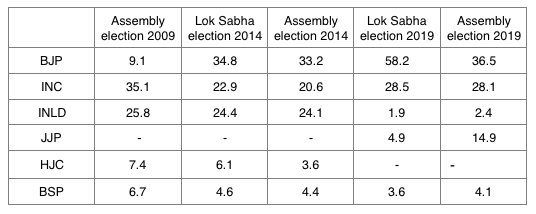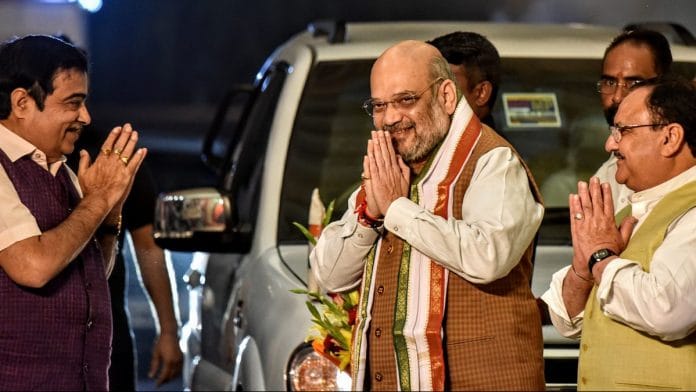In the run-up to the Haryana assembly election, the Hoodas and the Chautalas never looked like putting up a formidable challenge to the Bharatiya Janata Party’s juggernaut. But with the announcement of the result Thursday, they have stunned most election observers (including us) and checkmated Chief Minister Manohar Lal Khattar, who was expecting a comfortable return.
A quick, simplistic analysis of the BJP’s performance in the assembly elections will be to say that the party’s hold is waning and that the caste factors are back. But a more nuanced understanding is necessary, especially because of the stunning changes within just five months of Lok Sabha election.
One, the BJP may succeed in building a meta-narrative around national issues, but it remains on the back foot on local issues. Two, caste is no longer an evergreen in Indian election, but springs up more prominently in some elections, depending on many other factors. Three, concerns of economic well being cannot always be trumped by emotive issues of religious nationalism.
Also read: Maharashtra, Haryana send a message against the BJP’s arrogance of power
What the numbers tell us
In the 2014 Lok Sabha election, Congress’ Deepender Singh Hooda and Indian National Lok Dal (INLD)’s Dushyant Chautala (along with Charanjit Singh Channi) were the only candidates to withstand the BJP’s rise in Haryana. A few months later, Bhupinder Singh Hooda lost the power and the BJP formed the government in the state for the first time. By December 2018, Haryana’s principal opposition party, the INLD, had collapsed owing to a split, with Dushyant Chautala heading the new formation, Jannayak Janata Party (JJP).
The Hoodas seemed to be heading toward a political exile after their defeat in the 2019 Lok Sabha election, in which the Chautalas too could not save their bastions as the BJP stormed through winning all 10 seats in Haryana and polling 58 per cent of the votes. The stage was then set for Manohar Lal Khattar amid a weak and fragmented opposition, but now it has become clear that the old patriarchs of Jat politics in Haryana were working behind the scenes for a resurrection. The Hoodas were able to get the charge of the Congress’ campaign for the just concluded assembly election by successfully leading a rebellion against party’s state chief Ashok Tanwar. Dushyant Chautala, on the other hand, campaigned hard to present himself as the true heir of the legacy of former Deputy Prime Minister and twice Haryana’s Chief Minister Chaudhary Devi Lal.
While a correction in the BJP’s staggering 58 per cent vote share was well expected, a decline of nearly 20 percentage points suggests that the party clearly failed to read the voters’ sentiment. What explains the BJP’s underwhelming performance in Haryana? And, how did Bhoopinder Singh Hooda manage to turn around the Congress’ fortunes in less than six months?
Also read: These are the 9 MLAs BJP is trying to rope in to form govt in Haryana
BJP’s decline, opposition’s rise
The most important change in Haryana’s politics since the 2014 assembly election has been the split in the INLD and its near-complete electoral collapse (Table 1). In the 2019 Lok Sabha election, the BJP walked away with a larger portion of the INLD votes. In this assembly election, the INLD’s vote base got split. The JJP received the biggest chunk of the INLD’s base, followed by the Congress and other parties. The merger of Haryana Janhit Congress (HJC), led by former CM Bhajan Lal’s son Kuldeep Bishnoi, in the Congress party further added to Hooda senior’s fire power.
Table 1: Vote share of political parties in Haryana since 2009 (in %)

Source: Election Commission of India
Though the BJP managed to marginally increase its vote share in this election, the party’s vote-seat ratio declined significantly. It could manage to hold on to its gains made in north Haryana (Ambala, Kurukshetra and Panchkula region) and further consolidate its position in Gurgaon-Faridabad region. The Rohtak-Jhajjar belt in the east remained a bastion of the Hoodas, whereas Sirsa-Hisar region in the west largely supported Dushyant Chautala’s JJP. Chautala has not only managed to win a substantial portion of the INLD’s vote, but with 10 MLAs, he has emerged as a key player in the government formation in Haryana’s hung assembly.
The BJP’s vote base in Haryana in the pre-2019 Lok Sabha election era was largely non-Jat castes. The party gave a short shrift on the question of Jat quota, allocated fewer tickets to Jats in comparison to 2014 assembly election, and became too confident of an easy return owing to the factional feuds within the opposition parties. Haryana’s verdict leaves little doubt that the diminishing of the Jat-non-Jat binary in the 2019 Lok Sabha election was a mere aberration and that it is likely to remain a primary faultline in the state’s politics. It seems that Dalit voters too shied away from supporting the BJP in similar proportions as they had done in the past. Haryana has 21 per cent Dalit population and is among the top five states with Dalit population in the country.
Also read: Why the BJP at its peak is not dumping allies
Caste still a dominant factor
Is this the return of old-style caste politics? Many in TV studio debates Thursday were quick to declare that this election reinforces the primacy of caste in Indian elections. The reality, as always, remain more and needs more nuance. It is not enough to ask why the Jats did not vote for the BJP in this election. Rather, one should ask why did they vote for the party in the Lok Sabha election but old loyalties returned in this election. This indicates that rather than being the perennial gospel truth of Indian elections, caste voting is context conditional.
While the BJP still has a significant lead over the Congress party in terms of vote share, there is no doubt that the party’s base in Haryana remains fragile. In Lok Sabha elections, the BJP may draw on a bigger pool of voters in the name of Prime Minister Narendra Modi, its catchment area is limited in assembly elections with formidable leaders in opposition.
The BJP’s underwhelming performance in Haryana exposes the party’s limit in assembly elections, especially as an incumbent. In most state elections that the BJP has contested as an incumbent, the party’s performance has been sub-optimal. The Haryana assembly election result is a good reminder that under a slowing economy, opposition parties with formidable state-level leaders could mount a significant challenge to Modi-Amit Shah’s ambition of making the BJP a dominant party like the Congress of the 1950s.
Rahul Verma is Fellow at the Centre for Policy Research, Delhi. Pranav Gupta is a PhD student in political science at the University of California at Berkeley, US. Views are personal.







Did not the loud mouthed CM also lose. They must have raked in M…….s. So losing does not matter.
The only way democracy can be revived and saved and economy be resuscitated in India is through resurrection of the Congress and its allies, who split from the Congress .
This was an election that Congress could have won with sense and strategy. But as usual, Congress was wrought by its own inner indiscipline, faction fights, lack of direction and trusting the wrong leaders only on the basis of ‘Loyalty to The Family’. Now, Congress is reduced to merely gloating over the BJP’s discomfiture in losing a little ground. Congress has still not realised that their REAL LOSS is the state itself.
Kupraiki vizhundalum Meesaiki Man thattalai enru sollareenga. Sabash!!!!
BJP has a natural advantage if it sincerely addresses issues around hindu pride and concerns about islam. However, BJP has failed to do anything on these in significant ways. Hindus will gravitate to bjp naturally regardless of caste if BJP ensures good quality governance and economy. Its as simple as that, especially when congress with its islamic bent of mind cannot really be trusted.
Rejoice but everything passes in this world and BJP also will not be permanent.
Read the percentages as 33/32 against the actuals of 36/36
Even though the no seats is less, if one anayses the margins one can find it is around 20000 per seat on the average, for bjp whereas for others it is only less than 10000 or 5000. India to day boast it had predicted accurately in terms of seats its vote share prediction is widely off the mark viz aganst its prediction of 33/43 % the actuals are 47/26%
Natarajan
The fact that almost all sitting ministers lost their seats gives an indication of the quality of governance under CM Khattar.